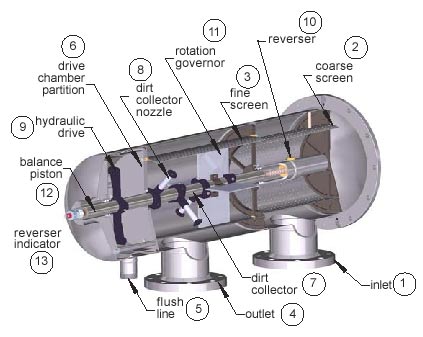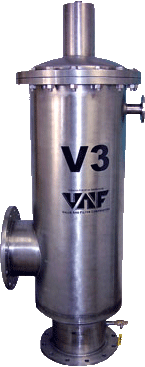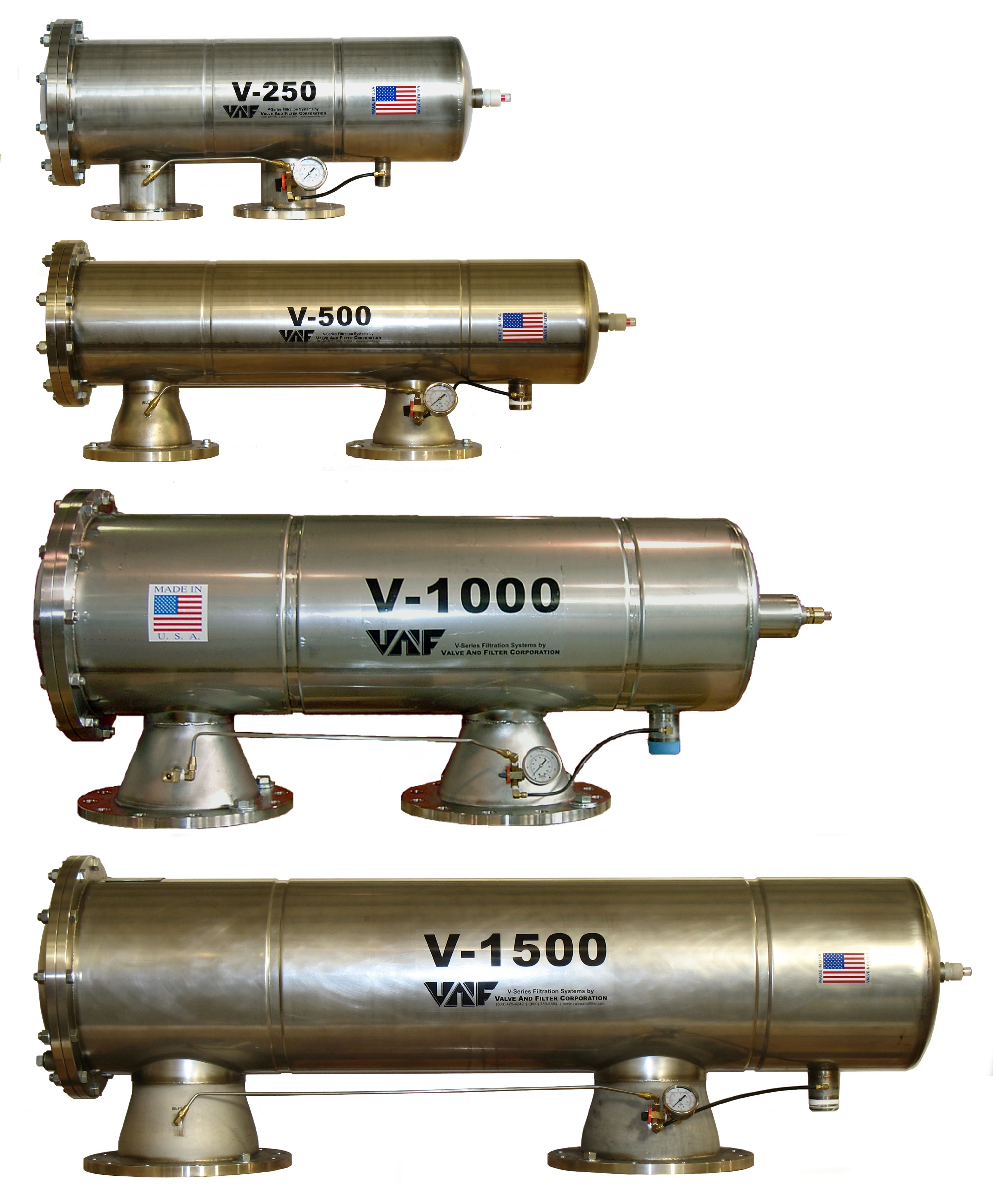How it works
 Please refer to the cutaway of the “V” series filter shown.
Please refer to the cutaway of the “V” series filter shown.
Dirty water enters the filter through the inlet (1) and then passes through the coarse screen (2) from the outside in. It flows from the inside of the coarse screen to the inside of the fine screen and then passes through the fine screen (3) from the inside out. Dirt is collected on the inside surface of the fine screen. The clean filtered water then exits through the filter outlet (4) and on to the system.
As the dirt or cake builds up on the inside surface of the fine screen, the pressure drop across the screen increases. When the pressure drop, (the DP or differential pressure) reaches a preset level of 0.5 bar (7 psi), the filter controller starts a flush cycle by opening a flush valve on the flush line (5). This flush valve exhausts the drive chamber to atmosphere at “0” psi.
The flush line (5) is connected to the drive chamber which is separated from the filtration chamber by a drive chamber partition (6). However, the dirt collector (7) (a hollow pipe with dirt collector nozzles) extends through the partition (6), thus providing a “path” from the dirt collector nozzles (8) through the hydraulic drive (9), into the drive chamber and out the flush line (5) to atmosphere. The pressure around the dirt collector nozzle (8) is the pressure inside the filter and as water flows through the “path”, it drops to “0” psi when it leaves the flush line (5). This creates an aggressive “suction” at the dirt collector nozzle (8) opening. The dirt collector nozzle (8) clearance at the fine screen (3) is very small. So, the extreme low pressure at the nozzle opening creates a backflow which “sucks” the dirt from the fine screen (3).
The hydraulic drive (9) has jets on opposite sides near its ends. Water jetting out of these openings (coming from the dirt collector nozzles (8)) creates a reaction force (like a pin wheel) which rotates the drive (9) and the dirt collector (7). As the dirt collector (7) rotates, each dirt collector nozzle (8) cleans a band on the fine screen (3). As the dirt collector (7) rotates, the reverser (10) (works like the level winder on your fishing reel) causes the hydraulic drive (9) / dirt collector (7) / dirt collector nozzle (8) assembly to move back and forth.
The rotation governor (11) helps control the rotation speed of the dirt collector (7) assembly. The balance piston (12) helps balance the transverse pressure on the assembly, and powers the reverser indicator (13) which provides visual indication of the dirt collector (7) assembly movement showing that the entire cleaning system is operating properly during the rinse cycle.
After a preset time, the flush valve closes and the rinse cycle is complete. Very little rinse water is used for each rinse. Please note the filter continues to supply water to the system during the rinse cycle.
Other Features
The complexity and cleaning efficiency of any self-cleaning screen filter is in the mechanical system that drives the cleaning process. The V-Series patented Bi-directional Hydrodynamic Drive (BHD) mechanism is the simplest and most efficient in design resulting in:
- fewer moving parts (no limit switches or pistons reversing the cleaning mechanism)
- simpler controls,
- lowest flush flow available,
- greater cleaning efficiency, and
- lower maintenance requirements
Model Overview
horizontal versions V250 - V1500
vertical version

large models V-2500 and V-3500 available
Specifications
General Specifications:
Bi-directional Hydrodynamic Drive
Max Pressure: 10 bar (150 psi)
Min Pressure: 2 bar (30 psi)
Max Temp: 80° C (176° F)
Flush Cycle: 12 to 15 seconds
Flow Range per Filter: 7 to 2,274 m³/hr
(30 to 10,000 gpm)
Flange Sizes: 3” to 40”
Screen Options: 10 to 1500 Micron on All Models
Manifold multiple units to increase flow ranges
Materials:
Filter Body — 316L standard; Super Duplex and Duplex SS for corrosive water
Screens — 316L SS Weave-wire
Seals — Nitrile, Viton, Silicone, EPDM
Options:
Pressure vessel ASME, Section VII, Div 1
Carbon steel, epoxy coated bodies are available on request on some models
Texts and graphs published with the kind permission of the supplier.

